Business Environment Report: Analysis of M&S and its Environment
VerifiedAdded on 2020/06/04
|12
|4308
|73
Report
AI Summary
This report provides a comprehensive analysis of the business environment, using Marks & Spencer (M&S) as a case study. It begins by defining the business environment and its impact on organizations, then explores different types of organizations (public limited, private limited, voluntary sector), their purposes, sizes, and scopes, with M&S highlighted as a private limited company. The report then examines the relationship between organizational functions (production, human resources, finance, marketing) and their link to organizational structures and objectives, emphasizing the importance of effective function performance for achieving business goals. Furthermore, it analyzes the positive and negative impacts of the macro environment (legal, political, economic, social, technological) on business operations. Finally, the report includes an internal and external analysis of M&S to identify its strengths and weaknesses, and it explores the interrelationship between these strengths/weaknesses and macro factors. The conclusion summarizes the key findings and implications of the analysis.
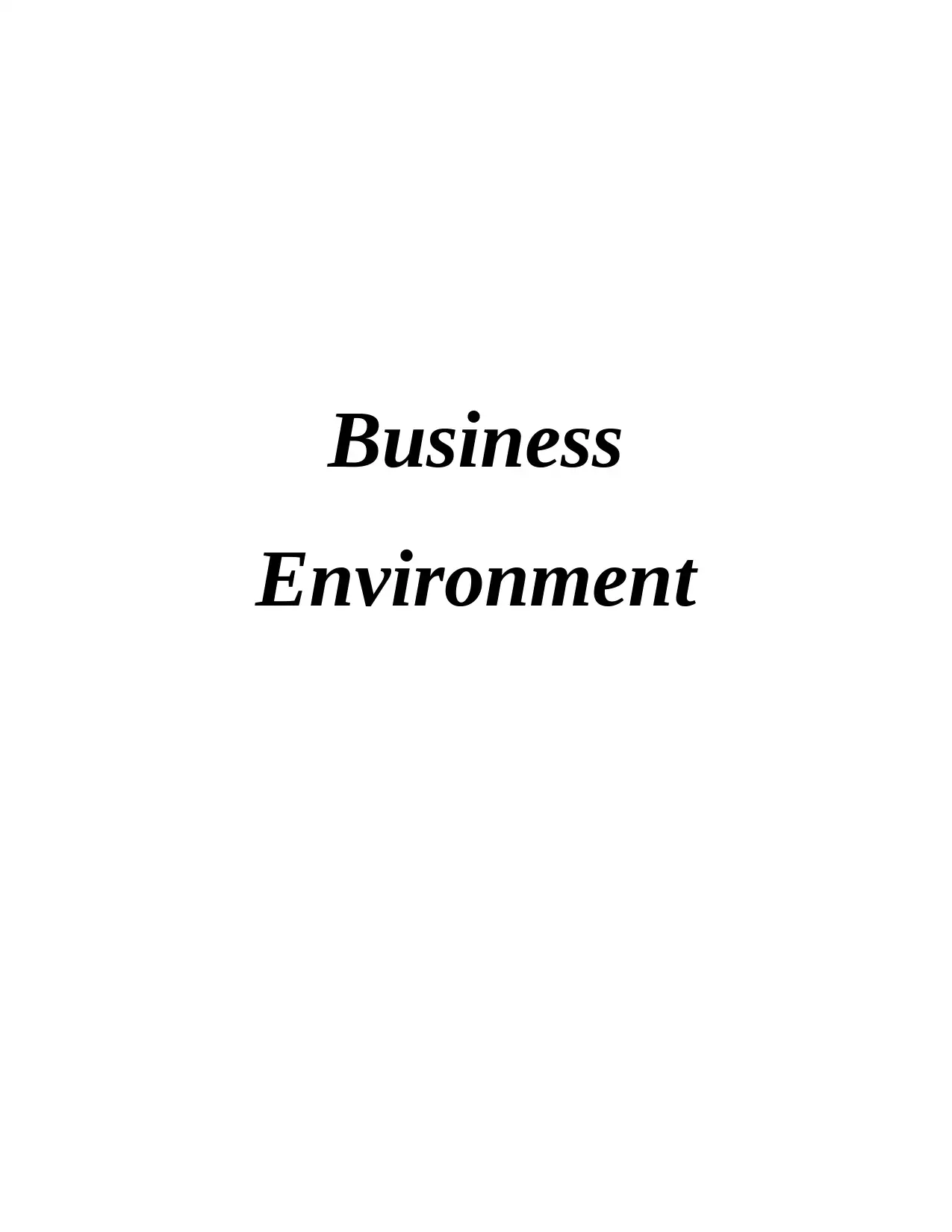
Business
Environment
Environment
Paraphrase This Document
Need a fresh take? Get an instant paraphrase of this document with our AI Paraphraser
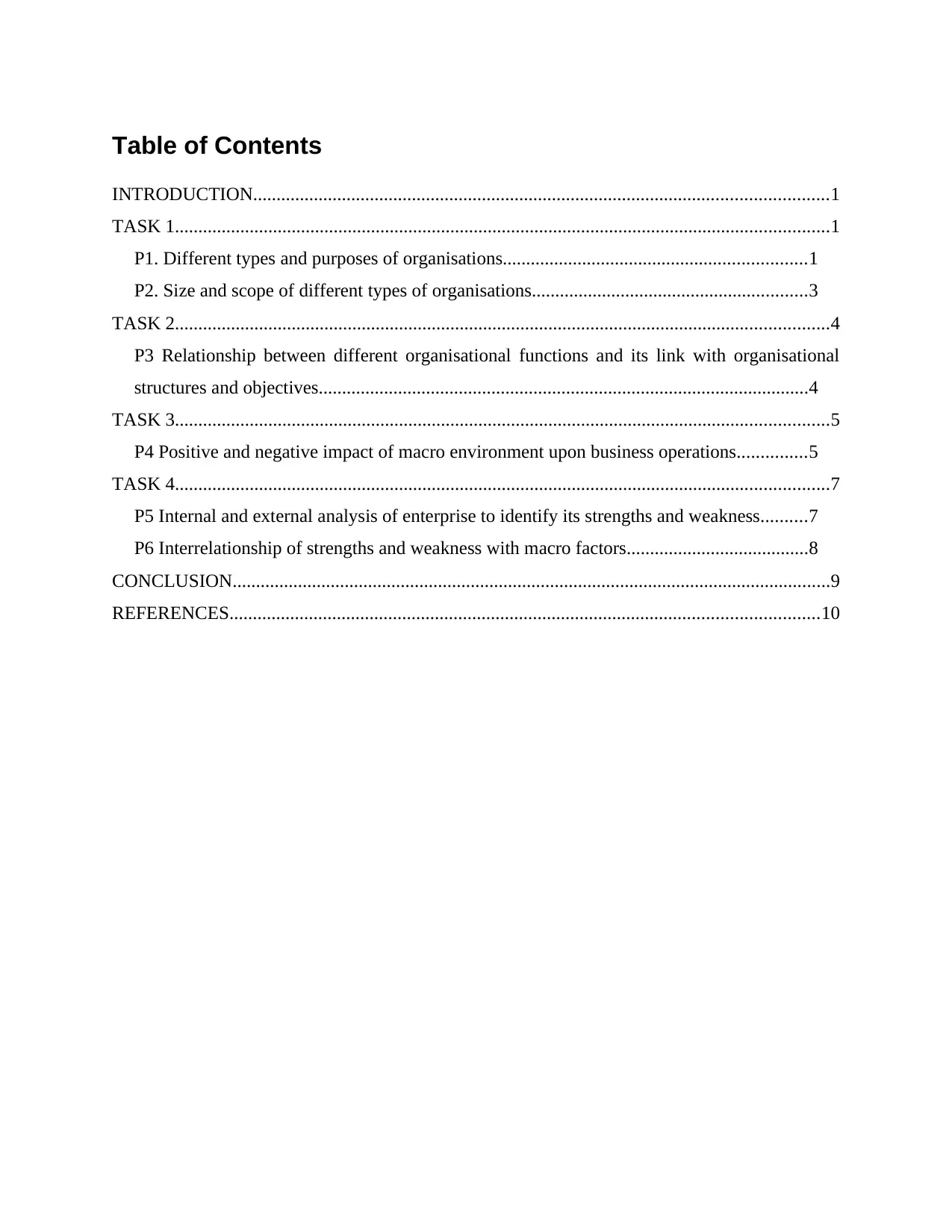
Table of Contents
INTRODUCTION...........................................................................................................................1
TASK 1............................................................................................................................................1
P1. Different types and purposes of organisations.................................................................1
P2. Size and scope of different types of organisations...........................................................3
TASK 2............................................................................................................................................4
P3 Relationship between different organisational functions and its link with organisational
structures and objectives.........................................................................................................4
TASK 3............................................................................................................................................5
P4 Positive and negative impact of macro environment upon business operations...............5
TASK 4............................................................................................................................................7
P5 Internal and external analysis of enterprise to identify its strengths and weakness..........7
P6 Interrelationship of strengths and weakness with macro factors.......................................8
CONCLUSION................................................................................................................................9
REFERENCES..............................................................................................................................10
INTRODUCTION...........................................................................................................................1
TASK 1............................................................................................................................................1
P1. Different types and purposes of organisations.................................................................1
P2. Size and scope of different types of organisations...........................................................3
TASK 2............................................................................................................................................4
P3 Relationship between different organisational functions and its link with organisational
structures and objectives.........................................................................................................4
TASK 3............................................................................................................................................5
P4 Positive and negative impact of macro environment upon business operations...............5
TASK 4............................................................................................................................................7
P5 Internal and external analysis of enterprise to identify its strengths and weakness..........7
P6 Interrelationship of strengths and weakness with macro factors.......................................8
CONCLUSION................................................................................................................................9
REFERENCES..............................................................................................................................10
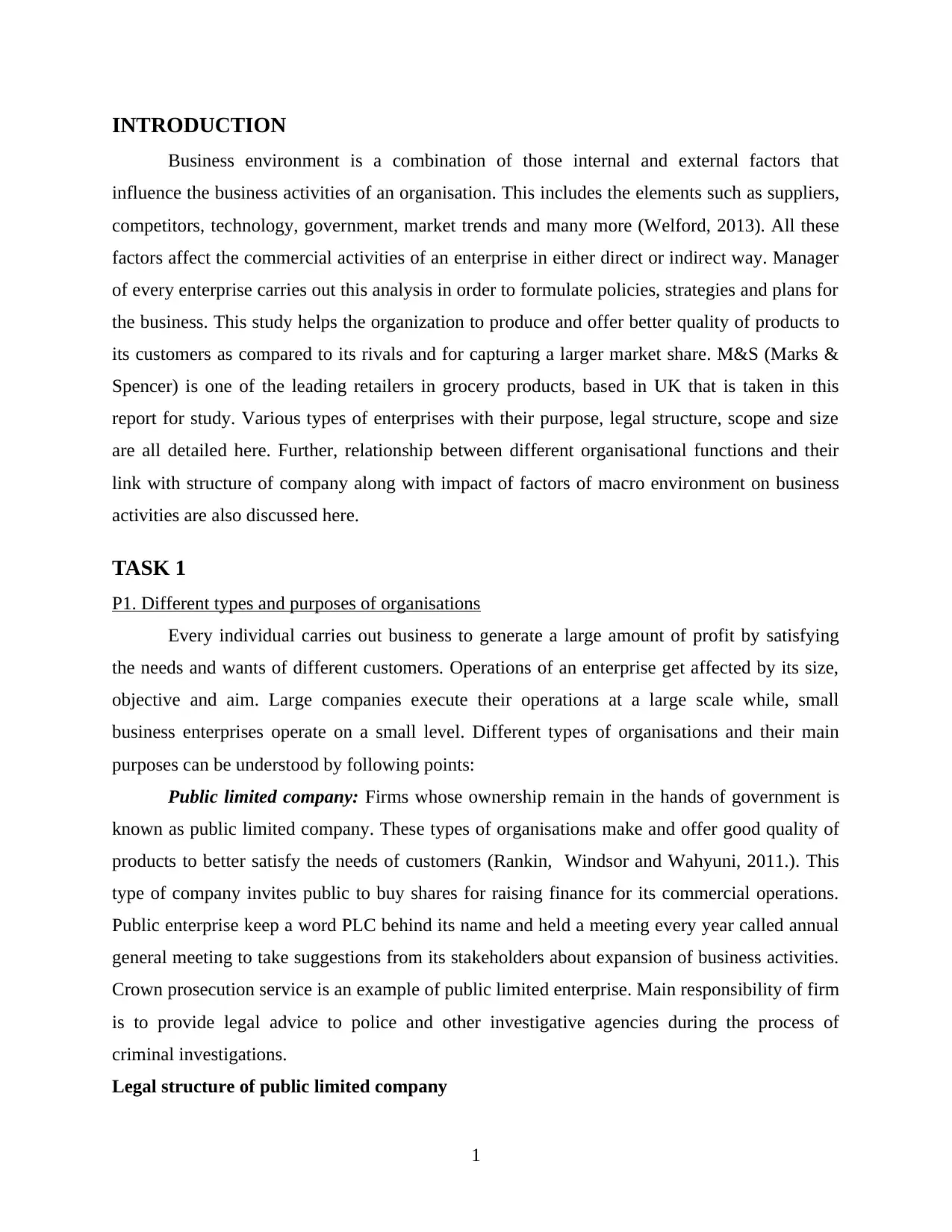
INTRODUCTION
Business environment is a combination of those internal and external factors that
influence the business activities of an organisation. This includes the elements such as suppliers,
competitors, technology, government, market trends and many more (Welford, 2013). All these
factors affect the commercial activities of an enterprise in either direct or indirect way. Manager
of every enterprise carries out this analysis in order to formulate policies, strategies and plans for
the business. This study helps the organization to produce and offer better quality of products to
its customers as compared to its rivals and for capturing a larger market share. M&S (Marks &
Spencer) is one of the leading retailers in grocery products, based in UK that is taken in this
report for study. Various types of enterprises with their purpose, legal structure, scope and size
are all detailed here. Further, relationship between different organisational functions and their
link with structure of company along with impact of factors of macro environment on business
activities are also discussed here.
TASK 1
P1. Different types and purposes of organisations
Every individual carries out business to generate a large amount of profit by satisfying
the needs and wants of different customers. Operations of an enterprise get affected by its size,
objective and aim. Large companies execute their operations at a large scale while, small
business enterprises operate on a small level. Different types of organisations and their main
purposes can be understood by following points:
Public limited company: Firms whose ownership remain in the hands of government is
known as public limited company. These types of organisations make and offer good quality of
products to better satisfy the needs of customers (Rankin, Windsor and Wahyuni, 2011.). This
type of company invites public to buy shares for raising finance for its commercial operations.
Public enterprise keep a word PLC behind its name and held a meeting every year called annual
general meeting to take suggestions from its stakeholders about expansion of business activities.
Crown prosecution service is an example of public limited enterprise. Main responsibility of firm
is to provide legal advice to police and other investigative agencies during the process of
criminal investigations.
Legal structure of public limited company
1
Business environment is a combination of those internal and external factors that
influence the business activities of an organisation. This includes the elements such as suppliers,
competitors, technology, government, market trends and many more (Welford, 2013). All these
factors affect the commercial activities of an enterprise in either direct or indirect way. Manager
of every enterprise carries out this analysis in order to formulate policies, strategies and plans for
the business. This study helps the organization to produce and offer better quality of products to
its customers as compared to its rivals and for capturing a larger market share. M&S (Marks &
Spencer) is one of the leading retailers in grocery products, based in UK that is taken in this
report for study. Various types of enterprises with their purpose, legal structure, scope and size
are all detailed here. Further, relationship between different organisational functions and their
link with structure of company along with impact of factors of macro environment on business
activities are also discussed here.
TASK 1
P1. Different types and purposes of organisations
Every individual carries out business to generate a large amount of profit by satisfying
the needs and wants of different customers. Operations of an enterprise get affected by its size,
objective and aim. Large companies execute their operations at a large scale while, small
business enterprises operate on a small level. Different types of organisations and their main
purposes can be understood by following points:
Public limited company: Firms whose ownership remain in the hands of government is
known as public limited company. These types of organisations make and offer good quality of
products to better satisfy the needs of customers (Rankin, Windsor and Wahyuni, 2011.). This
type of company invites public to buy shares for raising finance for its commercial operations.
Public enterprise keep a word PLC behind its name and held a meeting every year called annual
general meeting to take suggestions from its stakeholders about expansion of business activities.
Crown prosecution service is an example of public limited enterprise. Main responsibility of firm
is to provide legal advice to police and other investigative agencies during the process of
criminal investigations.
Legal structure of public limited company
1
⊘ This is a preview!⊘
Do you want full access?
Subscribe today to unlock all pages.

Trusted by 1+ million students worldwide
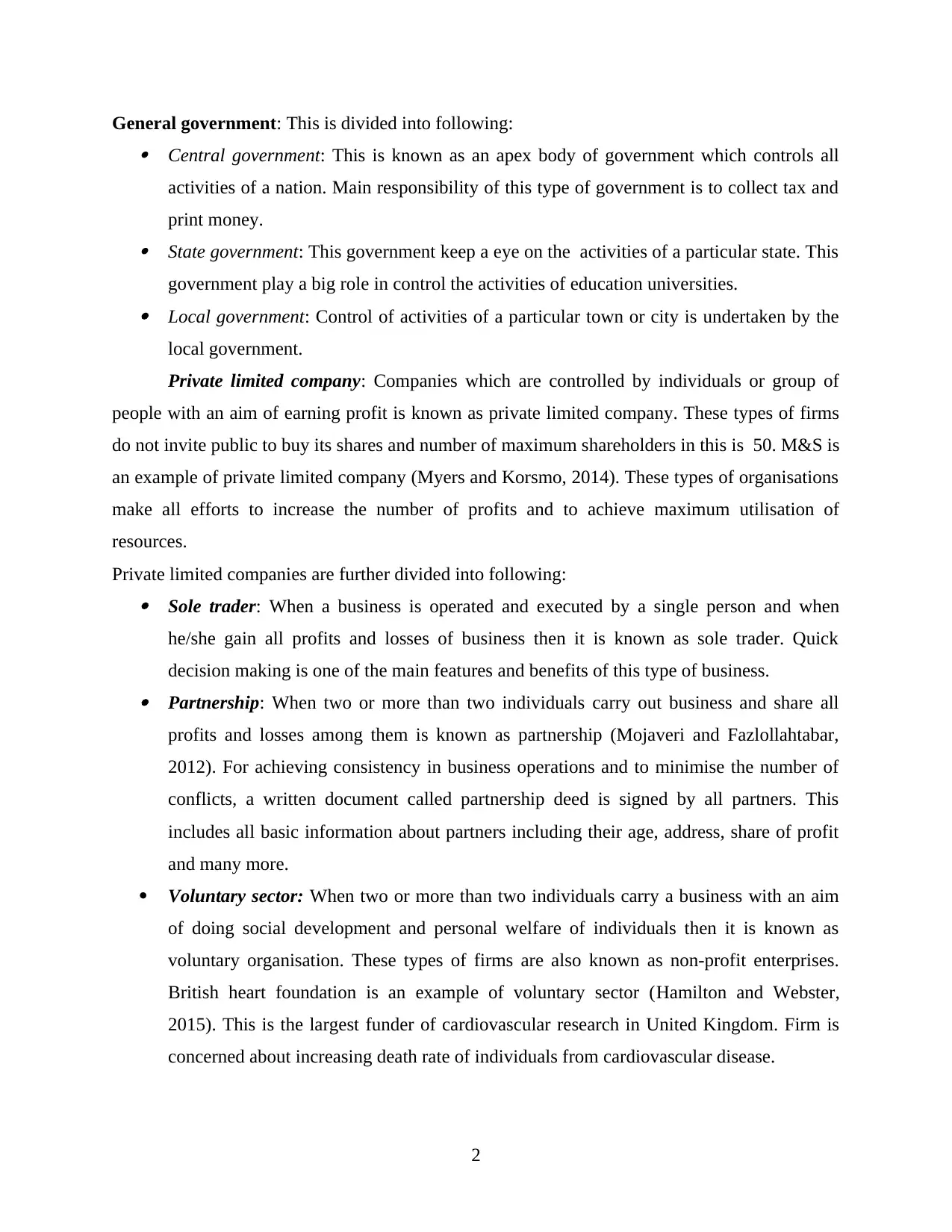
General government: This is divided into following: Central government: This is known as an apex body of government which controls all
activities of a nation. Main responsibility of this type of government is to collect tax and
print money. State government: This government keep a eye on the activities of a particular state. This
government play a big role in control the activities of education universities. Local government: Control of activities of a particular town or city is undertaken by the
local government.
Private limited company: Companies which are controlled by individuals or group of
people with an aim of earning profit is known as private limited company. These types of firms
do not invite public to buy its shares and number of maximum shareholders in this is 50. M&S is
an example of private limited company (Myers and Korsmo, 2014). These types of organisations
make all efforts to increase the number of profits and to achieve maximum utilisation of
resources.
Private limited companies are further divided into following: Sole trader: When a business is operated and executed by a single person and when
he/she gain all profits and losses of business then it is known as sole trader. Quick
decision making is one of the main features and benefits of this type of business. Partnership: When two or more than two individuals carry out business and share all
profits and losses among them is known as partnership (Mojaveri and Fazlollahtabar,
2012). For achieving consistency in business operations and to minimise the number of
conflicts, a written document called partnership deed is signed by all partners. This
includes all basic information about partners including their age, address, share of profit
and many more.
Voluntary sector: When two or more than two individuals carry a business with an aim
of doing social development and personal welfare of individuals then it is known as
voluntary organisation. These types of firms are also known as non-profit enterprises.
British heart foundation is an example of voluntary sector (Hamilton and Webster,
2015). This is the largest funder of cardiovascular research in United Kingdom. Firm is
concerned about increasing death rate of individuals from cardiovascular disease.
2
activities of a nation. Main responsibility of this type of government is to collect tax and
print money. State government: This government keep a eye on the activities of a particular state. This
government play a big role in control the activities of education universities. Local government: Control of activities of a particular town or city is undertaken by the
local government.
Private limited company: Companies which are controlled by individuals or group of
people with an aim of earning profit is known as private limited company. These types of firms
do not invite public to buy its shares and number of maximum shareholders in this is 50. M&S is
an example of private limited company (Myers and Korsmo, 2014). These types of organisations
make all efforts to increase the number of profits and to achieve maximum utilisation of
resources.
Private limited companies are further divided into following: Sole trader: When a business is operated and executed by a single person and when
he/she gain all profits and losses of business then it is known as sole trader. Quick
decision making is one of the main features and benefits of this type of business. Partnership: When two or more than two individuals carry out business and share all
profits and losses among them is known as partnership (Mojaveri and Fazlollahtabar,
2012). For achieving consistency in business operations and to minimise the number of
conflicts, a written document called partnership deed is signed by all partners. This
includes all basic information about partners including their age, address, share of profit
and many more.
Voluntary sector: When two or more than two individuals carry a business with an aim
of doing social development and personal welfare of individuals then it is known as
voluntary organisation. These types of firms are also known as non-profit enterprises.
British heart foundation is an example of voluntary sector (Hamilton and Webster,
2015). This is the largest funder of cardiovascular research in United Kingdom. Firm is
concerned about increasing death rate of individuals from cardiovascular disease.
2
Paraphrase This Document
Need a fresh take? Get an instant paraphrase of this document with our AI Paraphraser
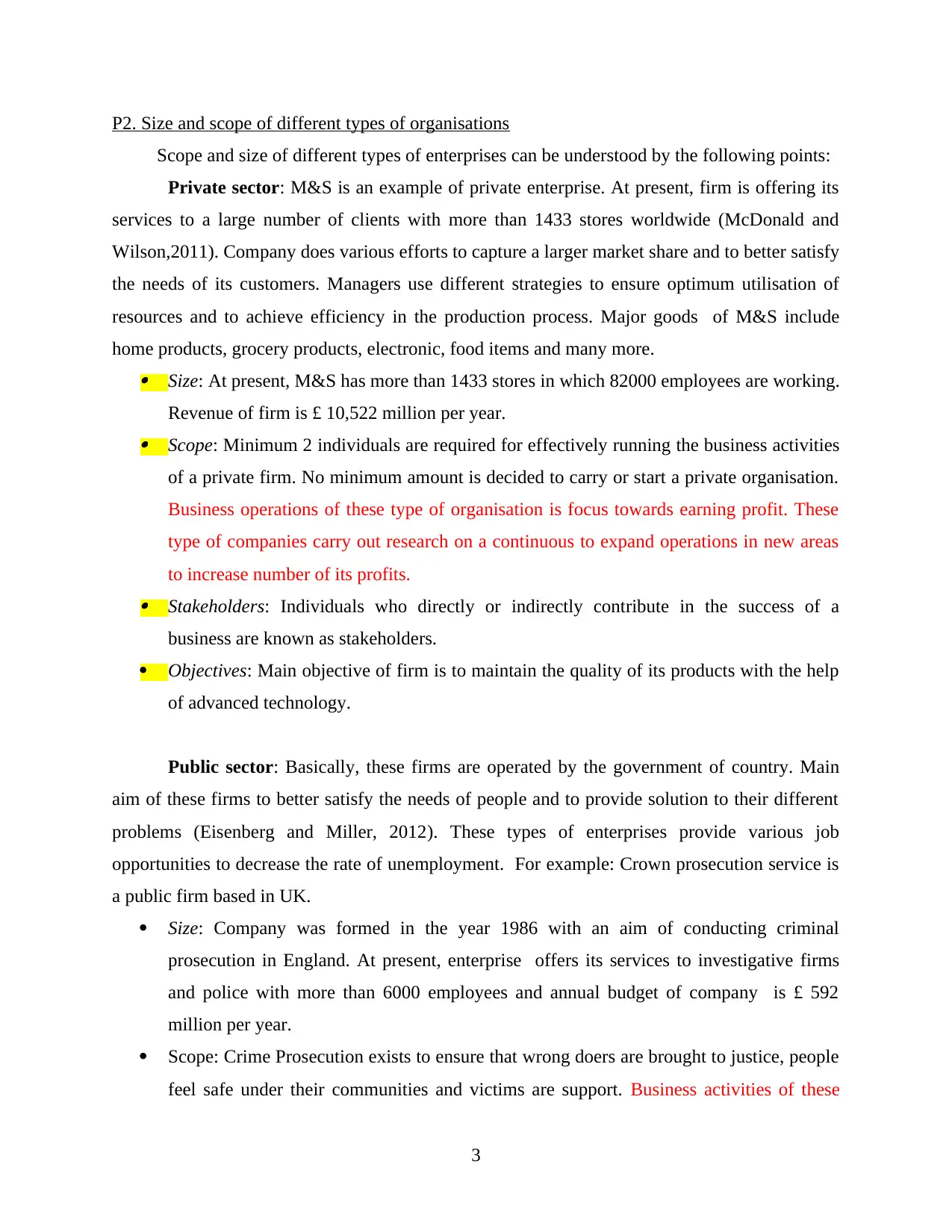
P2. Size and scope of different types of organisations
Scope and size of different types of enterprises can be understood by the following points:
Private sector: M&S is an example of private enterprise. At present, firm is offering its
services to a large number of clients with more than 1433 stores worldwide (McDonald and
Wilson,2011). Company does various efforts to capture a larger market share and to better satisfy
the needs of its customers. Managers use different strategies to ensure optimum utilisation of
resources and to achieve efficiency in the production process. Major goods of M&S include
home products, grocery products, electronic, food items and many more. Size: At present, M&S has more than 1433 stores in which 82000 employees are working.
Revenue of firm is £ 10,522 million per year. Scope: Minimum 2 individuals are required for effectively running the business activities
of a private firm. No minimum amount is decided to carry or start a private organisation.
Business operations of these type of organisation is focus towards earning profit. These
type of companies carry out research on a continuous to expand operations in new areas
to increase number of its profits. Stakeholders: Individuals who directly or indirectly contribute in the success of a
business are known as stakeholders.
Objectives: Main objective of firm is to maintain the quality of its products with the help
of advanced technology.
Public sector: Basically, these firms are operated by the government of country. Main
aim of these firms to better satisfy the needs of people and to provide solution to their different
problems (Eisenberg and Miller, 2012). These types of enterprises provide various job
opportunities to decrease the rate of unemployment. For example: Crown prosecution service is
a public firm based in UK.
Size: Company was formed in the year 1986 with an aim of conducting criminal
prosecution in England. At present, enterprise offers its services to investigative firms
and police with more than 6000 employees and annual budget of company is £ 592
million per year.
Scope: Crime Prosecution exists to ensure that wrong doers are brought to justice, people
feel safe under their communities and victims are support. Business activities of these
3
Scope and size of different types of enterprises can be understood by the following points:
Private sector: M&S is an example of private enterprise. At present, firm is offering its
services to a large number of clients with more than 1433 stores worldwide (McDonald and
Wilson,2011). Company does various efforts to capture a larger market share and to better satisfy
the needs of its customers. Managers use different strategies to ensure optimum utilisation of
resources and to achieve efficiency in the production process. Major goods of M&S include
home products, grocery products, electronic, food items and many more. Size: At present, M&S has more than 1433 stores in which 82000 employees are working.
Revenue of firm is £ 10,522 million per year. Scope: Minimum 2 individuals are required for effectively running the business activities
of a private firm. No minimum amount is decided to carry or start a private organisation.
Business operations of these type of organisation is focus towards earning profit. These
type of companies carry out research on a continuous to expand operations in new areas
to increase number of its profits. Stakeholders: Individuals who directly or indirectly contribute in the success of a
business are known as stakeholders.
Objectives: Main objective of firm is to maintain the quality of its products with the help
of advanced technology.
Public sector: Basically, these firms are operated by the government of country. Main
aim of these firms to better satisfy the needs of people and to provide solution to their different
problems (Eisenberg and Miller, 2012). These types of enterprises provide various job
opportunities to decrease the rate of unemployment. For example: Crown prosecution service is
a public firm based in UK.
Size: Company was formed in the year 1986 with an aim of conducting criminal
prosecution in England. At present, enterprise offers its services to investigative firms
and police with more than 6000 employees and annual budget of company is £ 592
million per year.
Scope: Crime Prosecution exists to ensure that wrong doers are brought to justice, people
feel safe under their communities and victims are support. Business activities of these
3
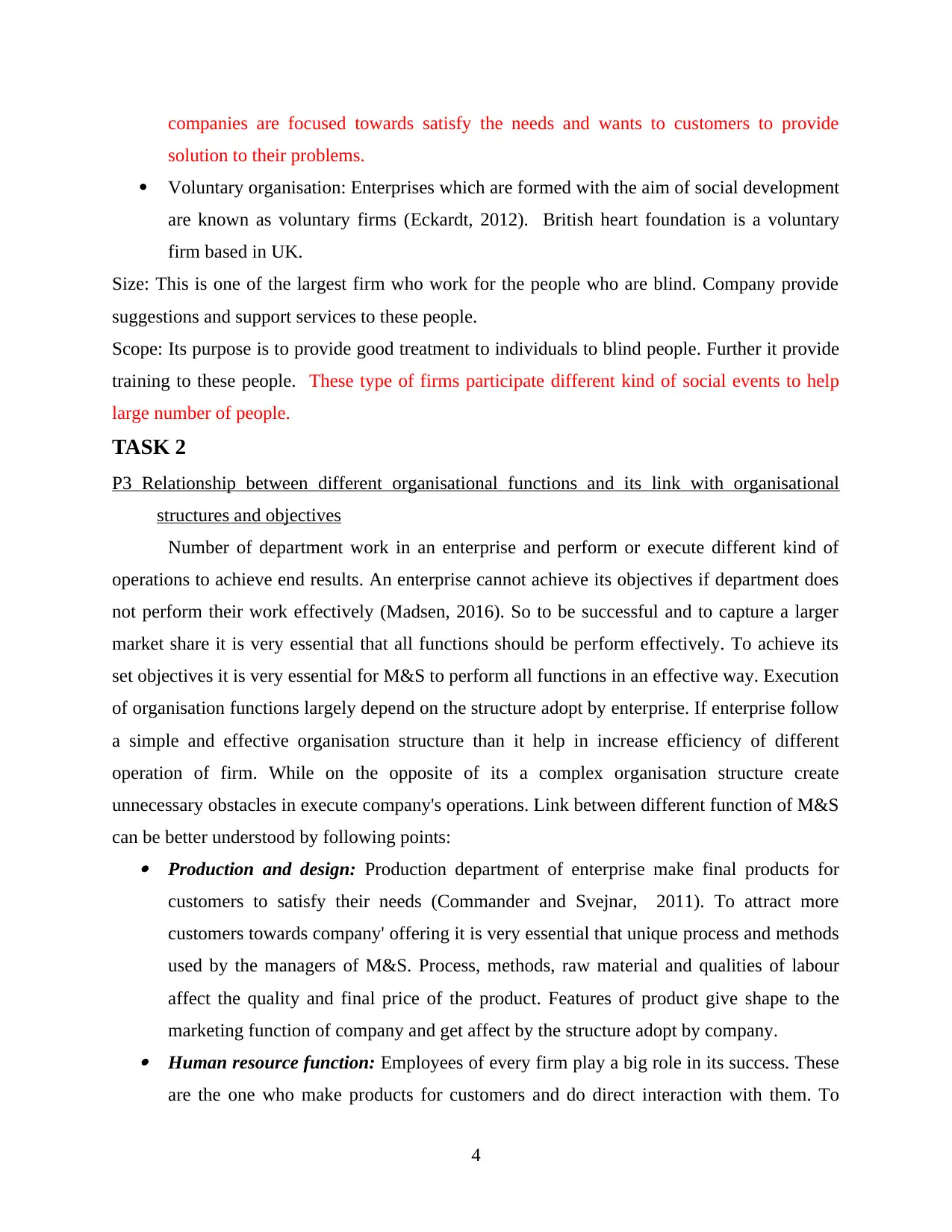
companies are focused towards satisfy the needs and wants to customers to provide
solution to their problems.
Voluntary organisation: Enterprises which are formed with the aim of social development
are known as voluntary firms (Eckardt, 2012). British heart foundation is a voluntary
firm based in UK.
Size: This is one of the largest firm who work for the people who are blind. Company provide
suggestions and support services to these people.
Scope: Its purpose is to provide good treatment to individuals to blind people. Further it provide
training to these people. These type of firms participate different kind of social events to help
large number of people.
TASK 2
P3 Relationship between different organisational functions and its link with organisational
structures and objectives
Number of department work in an enterprise and perform or execute different kind of
operations to achieve end results. An enterprise cannot achieve its objectives if department does
not perform their work effectively (Madsen, 2016). So to be successful and to capture a larger
market share it is very essential that all functions should be perform effectively. To achieve its
set objectives it is very essential for M&S to perform all functions in an effective way. Execution
of organisation functions largely depend on the structure adopt by enterprise. If enterprise follow
a simple and effective organisation structure than it help in increase efficiency of different
operation of firm. While on the opposite of its a complex organisation structure create
unnecessary obstacles in execute company's operations. Link between different function of M&S
can be better understood by following points: Production and design: Production department of enterprise make final products for
customers to satisfy their needs (Commander and Svejnar, 2011). To attract more
customers towards company' offering it is very essential that unique process and methods
used by the managers of M&S. Process, methods, raw material and qualities of labour
affect the quality and final price of the product. Features of product give shape to the
marketing function of company and get affect by the structure adopt by company. Human resource function: Employees of every firm play a big role in its success. These
are the one who make products for customers and do direct interaction with them. To
4
solution to their problems.
Voluntary organisation: Enterprises which are formed with the aim of social development
are known as voluntary firms (Eckardt, 2012). British heart foundation is a voluntary
firm based in UK.
Size: This is one of the largest firm who work for the people who are blind. Company provide
suggestions and support services to these people.
Scope: Its purpose is to provide good treatment to individuals to blind people. Further it provide
training to these people. These type of firms participate different kind of social events to help
large number of people.
TASK 2
P3 Relationship between different organisational functions and its link with organisational
structures and objectives
Number of department work in an enterprise and perform or execute different kind of
operations to achieve end results. An enterprise cannot achieve its objectives if department does
not perform their work effectively (Madsen, 2016). So to be successful and to capture a larger
market share it is very essential that all functions should be perform effectively. To achieve its
set objectives it is very essential for M&S to perform all functions in an effective way. Execution
of organisation functions largely depend on the structure adopt by enterprise. If enterprise follow
a simple and effective organisation structure than it help in increase efficiency of different
operation of firm. While on the opposite of its a complex organisation structure create
unnecessary obstacles in execute company's operations. Link between different function of M&S
can be better understood by following points: Production and design: Production department of enterprise make final products for
customers to satisfy their needs (Commander and Svejnar, 2011). To attract more
customers towards company' offering it is very essential that unique process and methods
used by the managers of M&S. Process, methods, raw material and qualities of labour
affect the quality and final price of the product. Features of product give shape to the
marketing function of company and get affect by the structure adopt by company. Human resource function: Employees of every firm play a big role in its success. These
are the one who make products for customers and do direct interaction with them. To
4
⊘ This is a preview!⊘
Do you want full access?
Subscribe today to unlock all pages.

Trusted by 1+ million students worldwide
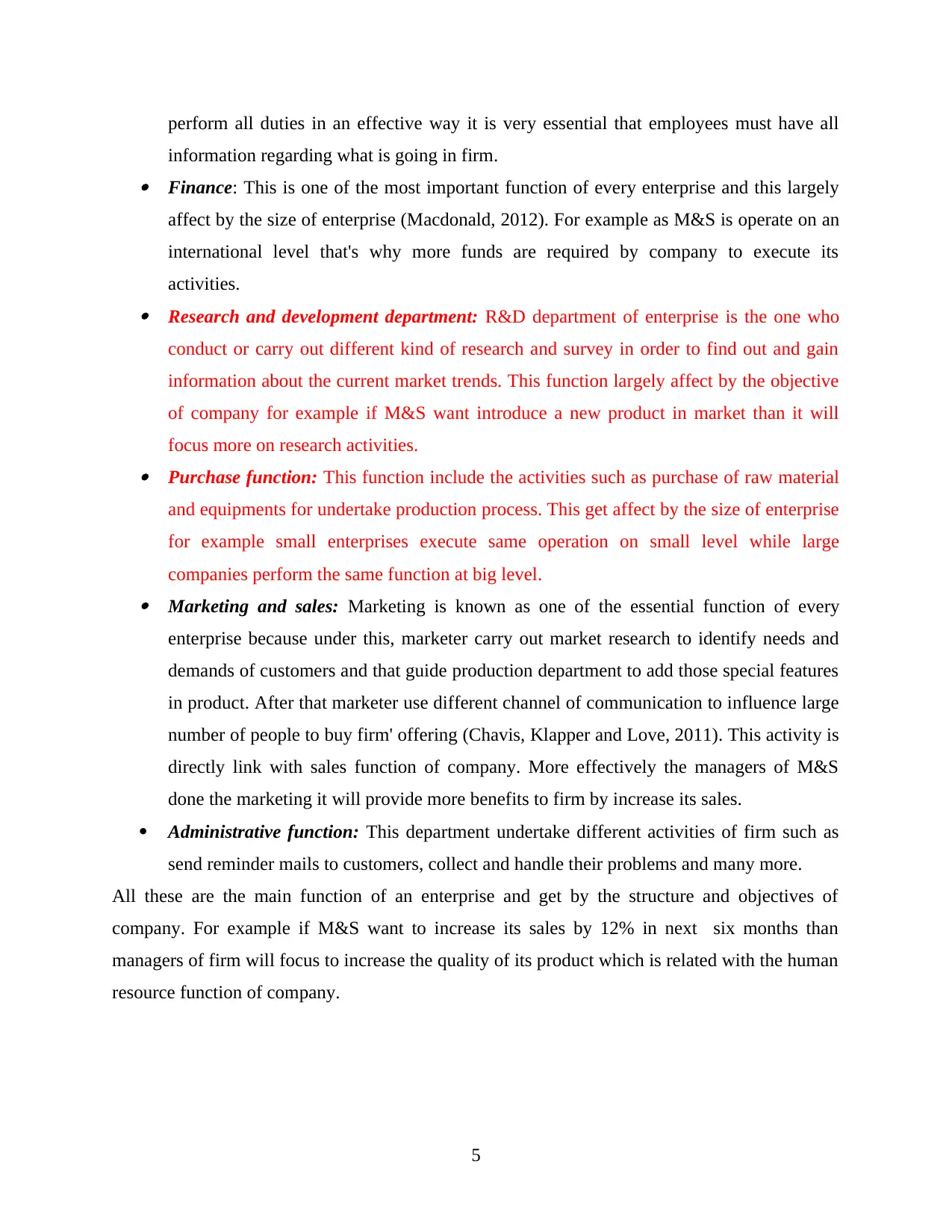
perform all duties in an effective way it is very essential that employees must have all
information regarding what is going in firm. Finance: This is one of the most important function of every enterprise and this largely
affect by the size of enterprise (Macdonald, 2012). For example as M&S is operate on an
international level that's why more funds are required by company to execute its
activities. Research and development department: R&D department of enterprise is the one who
conduct or carry out different kind of research and survey in order to find out and gain
information about the current market trends. This function largely affect by the objective
of company for example if M&S want introduce a new product in market than it will
focus more on research activities. Purchase function: This function include the activities such as purchase of raw material
and equipments for undertake production process. This get affect by the size of enterprise
for example small enterprises execute same operation on small level while large
companies perform the same function at big level. Marketing and sales: Marketing is known as one of the essential function of every
enterprise because under this, marketer carry out market research to identify needs and
demands of customers and that guide production department to add those special features
in product. After that marketer use different channel of communication to influence large
number of people to buy firm' offering (Chavis, Klapper and Love, 2011). This activity is
directly link with sales function of company. More effectively the managers of M&S
done the marketing it will provide more benefits to firm by increase its sales.
Administrative function: This department undertake different activities of firm such as
send reminder mails to customers, collect and handle their problems and many more.
All these are the main function of an enterprise and get by the structure and objectives of
company. For example if M&S want to increase its sales by 12% in next six months than
managers of firm will focus to increase the quality of its product which is related with the human
resource function of company.
5
information regarding what is going in firm. Finance: This is one of the most important function of every enterprise and this largely
affect by the size of enterprise (Macdonald, 2012). For example as M&S is operate on an
international level that's why more funds are required by company to execute its
activities. Research and development department: R&D department of enterprise is the one who
conduct or carry out different kind of research and survey in order to find out and gain
information about the current market trends. This function largely affect by the objective
of company for example if M&S want introduce a new product in market than it will
focus more on research activities. Purchase function: This function include the activities such as purchase of raw material
and equipments for undertake production process. This get affect by the size of enterprise
for example small enterprises execute same operation on small level while large
companies perform the same function at big level. Marketing and sales: Marketing is known as one of the essential function of every
enterprise because under this, marketer carry out market research to identify needs and
demands of customers and that guide production department to add those special features
in product. After that marketer use different channel of communication to influence large
number of people to buy firm' offering (Chavis, Klapper and Love, 2011). This activity is
directly link with sales function of company. More effectively the managers of M&S
done the marketing it will provide more benefits to firm by increase its sales.
Administrative function: This department undertake different activities of firm such as
send reminder mails to customers, collect and handle their problems and many more.
All these are the main function of an enterprise and get by the structure and objectives of
company. For example if M&S want to increase its sales by 12% in next six months than
managers of firm will focus to increase the quality of its product which is related with the human
resource function of company.
5
Paraphrase This Document
Need a fresh take? Get an instant paraphrase of this document with our AI Paraphraser
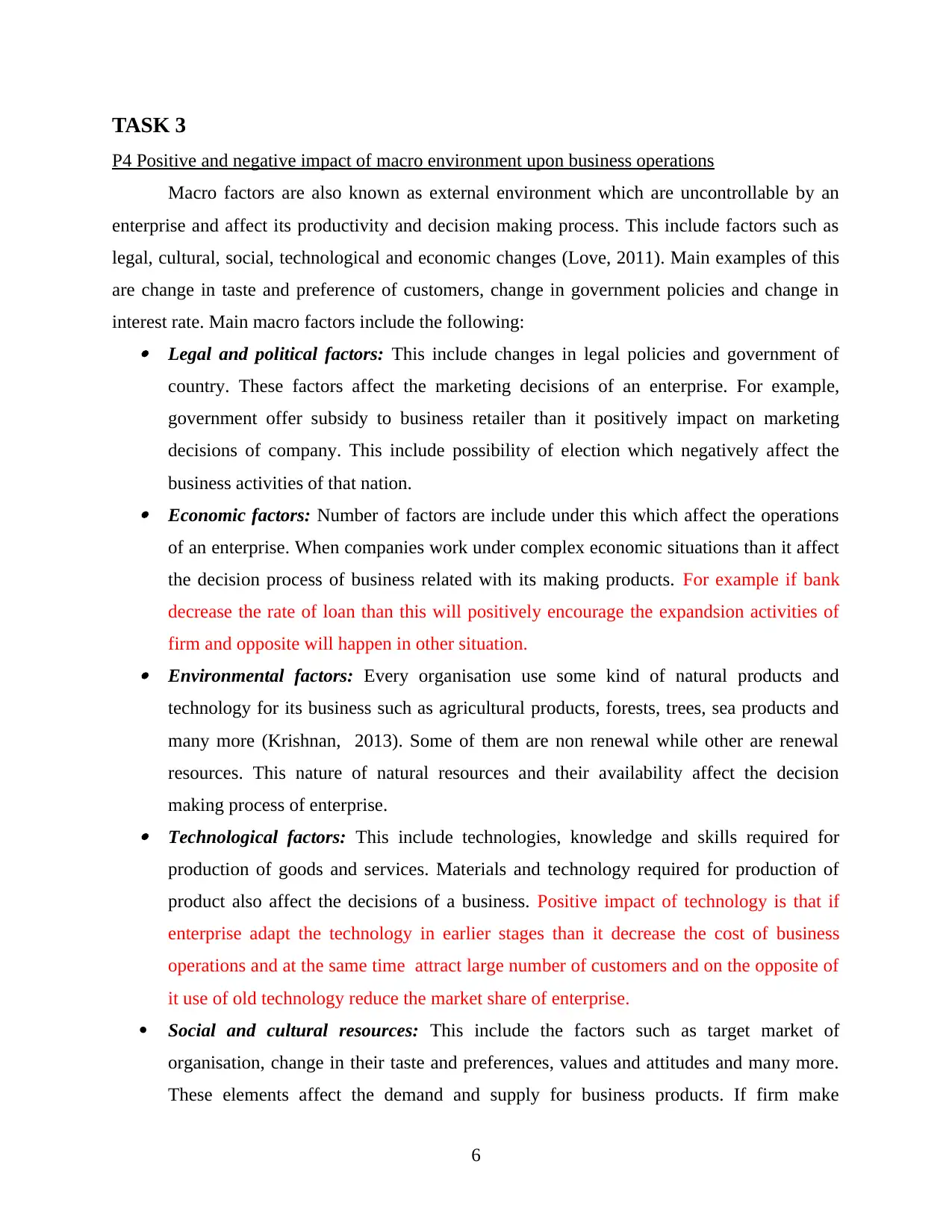
TASK 3
P4 Positive and negative impact of macro environment upon business operations
Macro factors are also known as external environment which are uncontrollable by an
enterprise and affect its productivity and decision making process. This include factors such as
legal, cultural, social, technological and economic changes (Love, 2011). Main examples of this
are change in taste and preference of customers, change in government policies and change in
interest rate. Main macro factors include the following: Legal and political factors: This include changes in legal policies and government of
country. These factors affect the marketing decisions of an enterprise. For example,
government offer subsidy to business retailer than it positively impact on marketing
decisions of company. This include possibility of election which negatively affect the
business activities of that nation. Economic factors: Number of factors are include under this which affect the operations
of an enterprise. When companies work under complex economic situations than it affect
the decision process of business related with its making products. For example if bank
decrease the rate of loan than this will positively encourage the expandsion activities of
firm and opposite will happen in other situation. Environmental factors: Every organisation use some kind of natural products and
technology for its business such as agricultural products, forests, trees, sea products and
many more (Krishnan, 2013). Some of them are non renewal while other are renewal
resources. This nature of natural resources and their availability affect the decision
making process of enterprise. Technological factors: This include technologies, knowledge and skills required for
production of goods and services. Materials and technology required for production of
product also affect the decisions of a business. Positive impact of technology is that if
enterprise adapt the technology in earlier stages than it decrease the cost of business
operations and at the same time attract large number of customers and on the opposite of
it use of old technology reduce the market share of enterprise.
Social and cultural resources: This include the factors such as target market of
organisation, change in their taste and preferences, values and attitudes and many more.
These elements affect the demand and supply for business products. If firm make
6
P4 Positive and negative impact of macro environment upon business operations
Macro factors are also known as external environment which are uncontrollable by an
enterprise and affect its productivity and decision making process. This include factors such as
legal, cultural, social, technological and economic changes (Love, 2011). Main examples of this
are change in taste and preference of customers, change in government policies and change in
interest rate. Main macro factors include the following: Legal and political factors: This include changes in legal policies and government of
country. These factors affect the marketing decisions of an enterprise. For example,
government offer subsidy to business retailer than it positively impact on marketing
decisions of company. This include possibility of election which negatively affect the
business activities of that nation. Economic factors: Number of factors are include under this which affect the operations
of an enterprise. When companies work under complex economic situations than it affect
the decision process of business related with its making products. For example if bank
decrease the rate of loan than this will positively encourage the expandsion activities of
firm and opposite will happen in other situation. Environmental factors: Every organisation use some kind of natural products and
technology for its business such as agricultural products, forests, trees, sea products and
many more (Krishnan, 2013). Some of them are non renewal while other are renewal
resources. This nature of natural resources and their availability affect the decision
making process of enterprise. Technological factors: This include technologies, knowledge and skills required for
production of goods and services. Materials and technology required for production of
product also affect the decisions of a business. Positive impact of technology is that if
enterprise adapt the technology in earlier stages than it decrease the cost of business
operations and at the same time attract large number of customers and on the opposite of
it use of old technology reduce the market share of enterprise.
Social and cultural resources: This include the factors such as target market of
organisation, change in their taste and preferences, values and attitudes and many more.
These elements affect the demand and supply for business products. If firm make
6
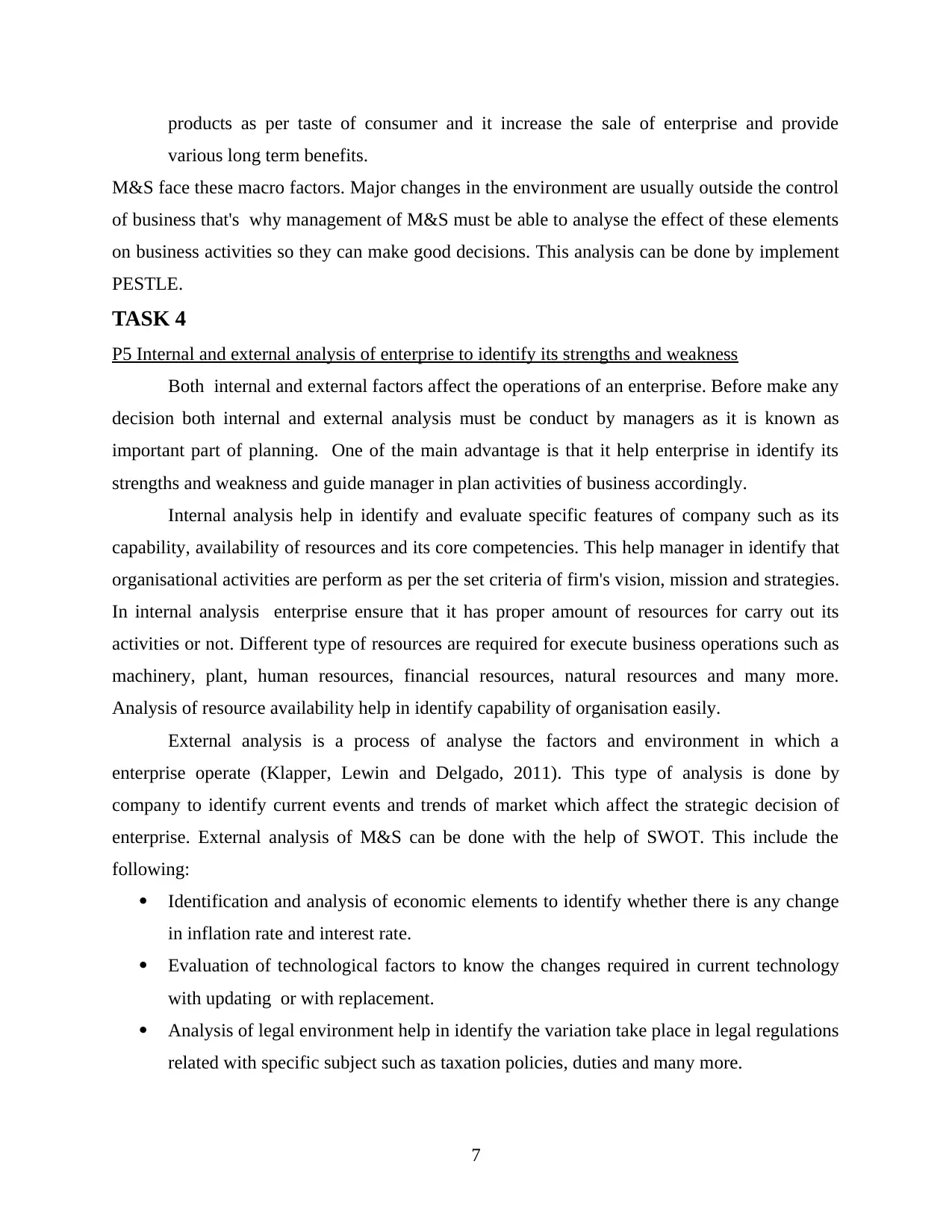
products as per taste of consumer and it increase the sale of enterprise and provide
various long term benefits.
M&S face these macro factors. Major changes in the environment are usually outside the control
of business that's why management of M&S must be able to analyse the effect of these elements
on business activities so they can make good decisions. This analysis can be done by implement
PESTLE.
TASK 4
P5 Internal and external analysis of enterprise to identify its strengths and weakness
Both internal and external factors affect the operations of an enterprise. Before make any
decision both internal and external analysis must be conduct by managers as it is known as
important part of planning. One of the main advantage is that it help enterprise in identify its
strengths and weakness and guide manager in plan activities of business accordingly.
Internal analysis help in identify and evaluate specific features of company such as its
capability, availability of resources and its core competencies. This help manager in identify that
organisational activities are perform as per the set criteria of firm's vision, mission and strategies.
In internal analysis enterprise ensure that it has proper amount of resources for carry out its
activities or not. Different type of resources are required for execute business operations such as
machinery, plant, human resources, financial resources, natural resources and many more.
Analysis of resource availability help in identify capability of organisation easily.
External analysis is a process of analyse the factors and environment in which a
enterprise operate (Klapper, Lewin and Delgado, 2011). This type of analysis is done by
company to identify current events and trends of market which affect the strategic decision of
enterprise. External analysis of M&S can be done with the help of SWOT. This include the
following:
Identification and analysis of economic elements to identify whether there is any change
in inflation rate and interest rate.
Evaluation of technological factors to know the changes required in current technology
with updating or with replacement.
Analysis of legal environment help in identify the variation take place in legal regulations
related with specific subject such as taxation policies, duties and many more.
7
various long term benefits.
M&S face these macro factors. Major changes in the environment are usually outside the control
of business that's why management of M&S must be able to analyse the effect of these elements
on business activities so they can make good decisions. This analysis can be done by implement
PESTLE.
TASK 4
P5 Internal and external analysis of enterprise to identify its strengths and weakness
Both internal and external factors affect the operations of an enterprise. Before make any
decision both internal and external analysis must be conduct by managers as it is known as
important part of planning. One of the main advantage is that it help enterprise in identify its
strengths and weakness and guide manager in plan activities of business accordingly.
Internal analysis help in identify and evaluate specific features of company such as its
capability, availability of resources and its core competencies. This help manager in identify that
organisational activities are perform as per the set criteria of firm's vision, mission and strategies.
In internal analysis enterprise ensure that it has proper amount of resources for carry out its
activities or not. Different type of resources are required for execute business operations such as
machinery, plant, human resources, financial resources, natural resources and many more.
Analysis of resource availability help in identify capability of organisation easily.
External analysis is a process of analyse the factors and environment in which a
enterprise operate (Klapper, Lewin and Delgado, 2011). This type of analysis is done by
company to identify current events and trends of market which affect the strategic decision of
enterprise. External analysis of M&S can be done with the help of SWOT. This include the
following:
Identification and analysis of economic elements to identify whether there is any change
in inflation rate and interest rate.
Evaluation of technological factors to know the changes required in current technology
with updating or with replacement.
Analysis of legal environment help in identify the variation take place in legal regulations
related with specific subject such as taxation policies, duties and many more.
7
⊘ This is a preview!⊘
Do you want full access?
Subscribe today to unlock all pages.

Trusted by 1+ million students worldwide
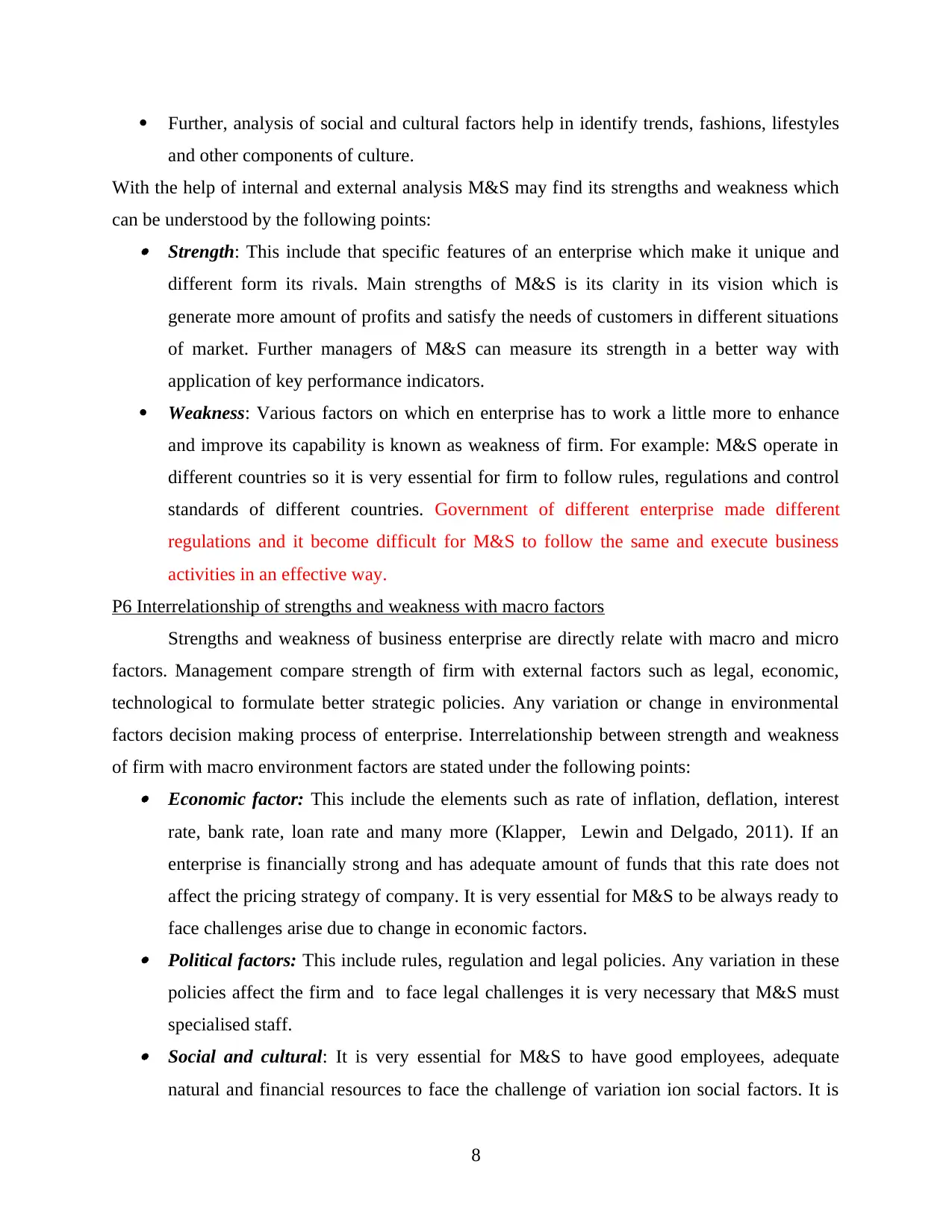
Further, analysis of social and cultural factors help in identify trends, fashions, lifestyles
and other components of culture.
With the help of internal and external analysis M&S may find its strengths and weakness which
can be understood by the following points: Strength: This include that specific features of an enterprise which make it unique and
different form its rivals. Main strengths of M&S is its clarity in its vision which is
generate more amount of profits and satisfy the needs of customers in different situations
of market. Further managers of M&S can measure its strength in a better way with
application of key performance indicators.
Weakness: Various factors on which en enterprise has to work a little more to enhance
and improve its capability is known as weakness of firm. For example: M&S operate in
different countries so it is very essential for firm to follow rules, regulations and control
standards of different countries. Government of different enterprise made different
regulations and it become difficult for M&S to follow the same and execute business
activities in an effective way.
P6 Interrelationship of strengths and weakness with macro factors
Strengths and weakness of business enterprise are directly relate with macro and micro
factors. Management compare strength of firm with external factors such as legal, economic,
technological to formulate better strategic policies. Any variation or change in environmental
factors decision making process of enterprise. Interrelationship between strength and weakness
of firm with macro environment factors are stated under the following points: Economic factor: This include the elements such as rate of inflation, deflation, interest
rate, bank rate, loan rate and many more (Klapper, Lewin and Delgado, 2011). If an
enterprise is financially strong and has adequate amount of funds that this rate does not
affect the pricing strategy of company. It is very essential for M&S to be always ready to
face challenges arise due to change in economic factors. Political factors: This include rules, regulation and legal policies. Any variation in these
policies affect the firm and to face legal challenges it is very necessary that M&S must
specialised staff. Social and cultural: It is very essential for M&S to have good employees, adequate
natural and financial resources to face the challenge of variation ion social factors. It is
8
and other components of culture.
With the help of internal and external analysis M&S may find its strengths and weakness which
can be understood by the following points: Strength: This include that specific features of an enterprise which make it unique and
different form its rivals. Main strengths of M&S is its clarity in its vision which is
generate more amount of profits and satisfy the needs of customers in different situations
of market. Further managers of M&S can measure its strength in a better way with
application of key performance indicators.
Weakness: Various factors on which en enterprise has to work a little more to enhance
and improve its capability is known as weakness of firm. For example: M&S operate in
different countries so it is very essential for firm to follow rules, regulations and control
standards of different countries. Government of different enterprise made different
regulations and it become difficult for M&S to follow the same and execute business
activities in an effective way.
P6 Interrelationship of strengths and weakness with macro factors
Strengths and weakness of business enterprise are directly relate with macro and micro
factors. Management compare strength of firm with external factors such as legal, economic,
technological to formulate better strategic policies. Any variation or change in environmental
factors decision making process of enterprise. Interrelationship between strength and weakness
of firm with macro environment factors are stated under the following points: Economic factor: This include the elements such as rate of inflation, deflation, interest
rate, bank rate, loan rate and many more (Klapper, Lewin and Delgado, 2011). If an
enterprise is financially strong and has adequate amount of funds that this rate does not
affect the pricing strategy of company. It is very essential for M&S to be always ready to
face challenges arise due to change in economic factors. Political factors: This include rules, regulation and legal policies. Any variation in these
policies affect the firm and to face legal challenges it is very necessary that M&S must
specialised staff. Social and cultural: It is very essential for M&S to have good employees, adequate
natural and financial resources to face the challenge of variation ion social factors. It is
8
Paraphrase This Document
Need a fresh take? Get an instant paraphrase of this document with our AI Paraphraser
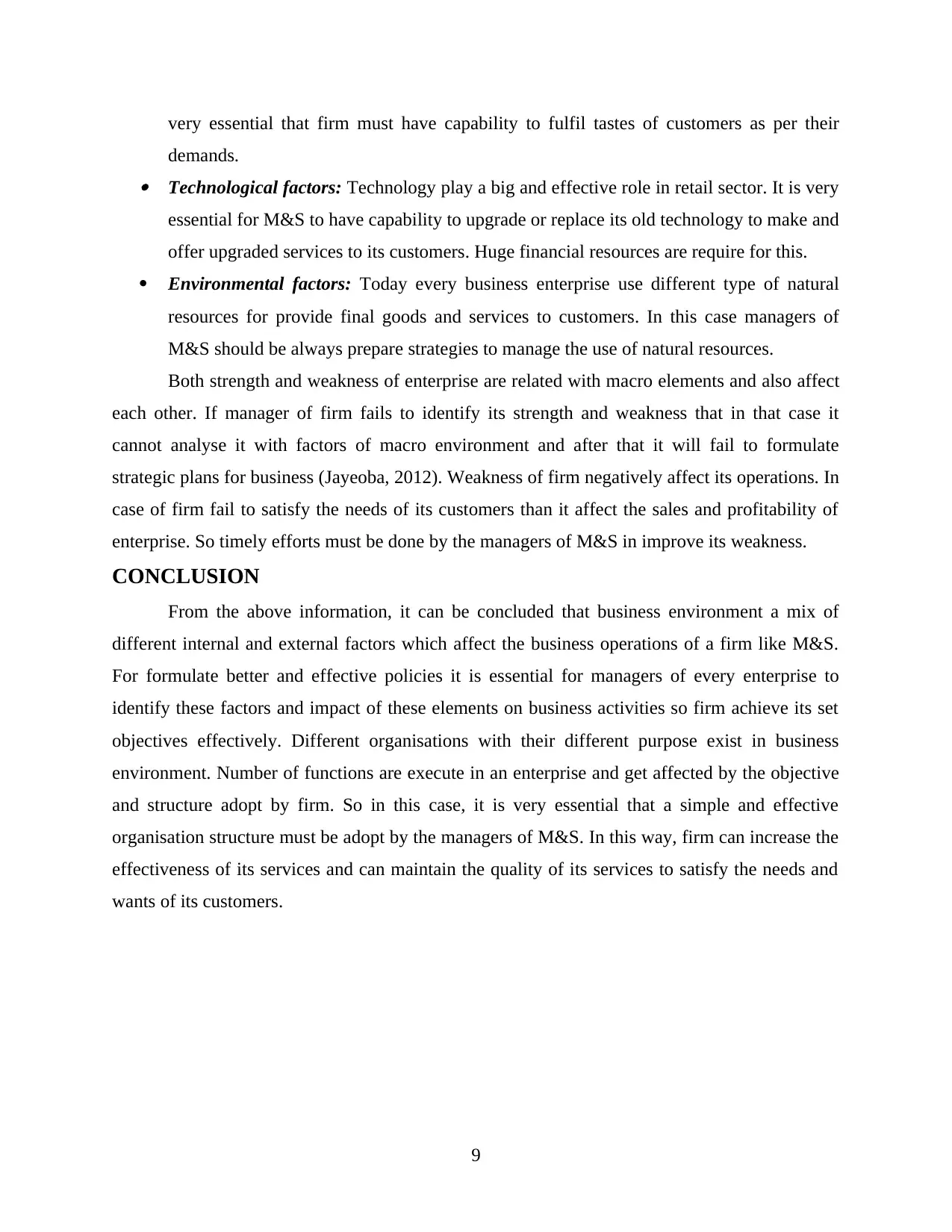
very essential that firm must have capability to fulfil tastes of customers as per their
demands. Technological factors: Technology play a big and effective role in retail sector. It is very
essential for M&S to have capability to upgrade or replace its old technology to make and
offer upgraded services to its customers. Huge financial resources are require for this.
Environmental factors: Today every business enterprise use different type of natural
resources for provide final goods and services to customers. In this case managers of
M&S should be always prepare strategies to manage the use of natural resources.
Both strength and weakness of enterprise are related with macro elements and also affect
each other. If manager of firm fails to identify its strength and weakness that in that case it
cannot analyse it with factors of macro environment and after that it will fail to formulate
strategic plans for business (Jayeoba, 2012). Weakness of firm negatively affect its operations. In
case of firm fail to satisfy the needs of its customers than it affect the sales and profitability of
enterprise. So timely efforts must be done by the managers of M&S in improve its weakness.
CONCLUSION
From the above information, it can be concluded that business environment a mix of
different internal and external factors which affect the business operations of a firm like M&S.
For formulate better and effective policies it is essential for managers of every enterprise to
identify these factors and impact of these elements on business activities so firm achieve its set
objectives effectively. Different organisations with their different purpose exist in business
environment. Number of functions are execute in an enterprise and get affected by the objective
and structure adopt by firm. So in this case, it is very essential that a simple and effective
organisation structure must be adopt by the managers of M&S. In this way, firm can increase the
effectiveness of its services and can maintain the quality of its services to satisfy the needs and
wants of its customers.
9
demands. Technological factors: Technology play a big and effective role in retail sector. It is very
essential for M&S to have capability to upgrade or replace its old technology to make and
offer upgraded services to its customers. Huge financial resources are require for this.
Environmental factors: Today every business enterprise use different type of natural
resources for provide final goods and services to customers. In this case managers of
M&S should be always prepare strategies to manage the use of natural resources.
Both strength and weakness of enterprise are related with macro elements and also affect
each other. If manager of firm fails to identify its strength and weakness that in that case it
cannot analyse it with factors of macro environment and after that it will fail to formulate
strategic plans for business (Jayeoba, 2012). Weakness of firm negatively affect its operations. In
case of firm fail to satisfy the needs of its customers than it affect the sales and profitability of
enterprise. So timely efforts must be done by the managers of M&S in improve its weakness.
CONCLUSION
From the above information, it can be concluded that business environment a mix of
different internal and external factors which affect the business operations of a firm like M&S.
For formulate better and effective policies it is essential for managers of every enterprise to
identify these factors and impact of these elements on business activities so firm achieve its set
objectives effectively. Different organisations with their different purpose exist in business
environment. Number of functions are execute in an enterprise and get affected by the objective
and structure adopt by firm. So in this case, it is very essential that a simple and effective
organisation structure must be adopt by the managers of M&S. In this way, firm can increase the
effectiveness of its services and can maintain the quality of its services to satisfy the needs and
wants of its customers.
9
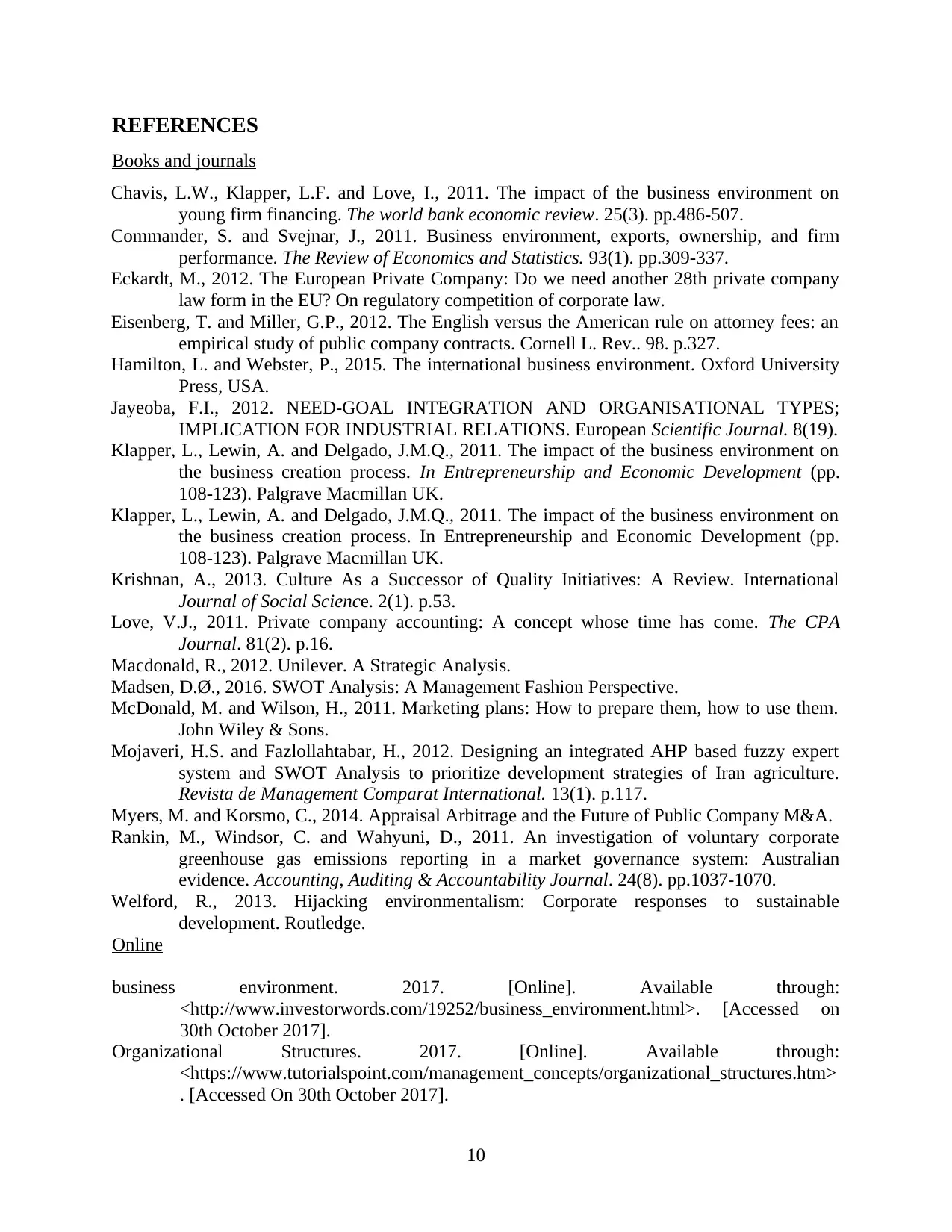
REFERENCES
Books and journals
Chavis, L.W., Klapper, L.F. and Love, I., 2011. The impact of the business environment on
young firm financing. The world bank economic review. 25(3). pp.486-507.
Commander, S. and Svejnar, J., 2011. Business environment, exports, ownership, and firm
performance. The Review of Economics and Statistics. 93(1). pp.309-337.
Eckardt, M., 2012. The European Private Company: Do we need another 28th private company
law form in the EU? On regulatory competition of corporate law.
Eisenberg, T. and Miller, G.P., 2012. The English versus the American rule on attorney fees: an
empirical study of public company contracts. Cornell L. Rev.. 98. p.327.
Hamilton, L. and Webster, P., 2015. The international business environment. Oxford University
Press, USA.
Jayeoba, F.I., 2012. NEED-GOAL INTEGRATION AND ORGANISATIONAL TYPES;
IMPLICATION FOR INDUSTRIAL RELATIONS. European Scientific Journal. 8(19).
Klapper, L., Lewin, A. and Delgado, J.M.Q., 2011. The impact of the business environment on
the business creation process. In Entrepreneurship and Economic Development (pp.
108-123). Palgrave Macmillan UK.
Klapper, L., Lewin, A. and Delgado, J.M.Q., 2011. The impact of the business environment on
the business creation process. In Entrepreneurship and Economic Development (pp.
108-123). Palgrave Macmillan UK.
Krishnan, A., 2013. Culture As a Successor of Quality Initiatives: A Review. International
Journal of Social Science. 2(1). p.53.
Love, V.J., 2011. Private company accounting: A concept whose time has come. The CPA
Journal. 81(2). p.16.
Macdonald, R., 2012. Unilever. A Strategic Analysis.
Madsen, D.Ø., 2016. SWOT Analysis: A Management Fashion Perspective.
McDonald, M. and Wilson, H., 2011. Marketing plans: How to prepare them, how to use them.
John Wiley & Sons.
Mojaveri, H.S. and Fazlollahtabar, H., 2012. Designing an integrated AHP based fuzzy expert
system and SWOT Analysis to prioritize development strategies of Iran agriculture.
Revista de Management Comparat International. 13(1). p.117.
Myers, M. and Korsmo, C., 2014. Appraisal Arbitrage and the Future of Public Company M&A.
Rankin, M., Windsor, C. and Wahyuni, D., 2011. An investigation of voluntary corporate
greenhouse gas emissions reporting in a market governance system: Australian
evidence. Accounting, Auditing & Accountability Journal. 24(8). pp.1037-1070.
Welford, R., 2013. Hijacking environmentalism: Corporate responses to sustainable
development. Routledge.
Online
business environment. 2017. [Online]. Available through:
<http://www.investorwords.com/19252/business_environment.html>. [Accessed on
30th October 2017].
Organizational Structures. 2017. [Online]. Available through:
<https://www.tutorialspoint.com/management_concepts/organizational_structures.htm>
. [Accessed On 30th October 2017].
10
Books and journals
Chavis, L.W., Klapper, L.F. and Love, I., 2011. The impact of the business environment on
young firm financing. The world bank economic review. 25(3). pp.486-507.
Commander, S. and Svejnar, J., 2011. Business environment, exports, ownership, and firm
performance. The Review of Economics and Statistics. 93(1). pp.309-337.
Eckardt, M., 2012. The European Private Company: Do we need another 28th private company
law form in the EU? On regulatory competition of corporate law.
Eisenberg, T. and Miller, G.P., 2012. The English versus the American rule on attorney fees: an
empirical study of public company contracts. Cornell L. Rev.. 98. p.327.
Hamilton, L. and Webster, P., 2015. The international business environment. Oxford University
Press, USA.
Jayeoba, F.I., 2012. NEED-GOAL INTEGRATION AND ORGANISATIONAL TYPES;
IMPLICATION FOR INDUSTRIAL RELATIONS. European Scientific Journal. 8(19).
Klapper, L., Lewin, A. and Delgado, J.M.Q., 2011. The impact of the business environment on
the business creation process. In Entrepreneurship and Economic Development (pp.
108-123). Palgrave Macmillan UK.
Klapper, L., Lewin, A. and Delgado, J.M.Q., 2011. The impact of the business environment on
the business creation process. In Entrepreneurship and Economic Development (pp.
108-123). Palgrave Macmillan UK.
Krishnan, A., 2013. Culture As a Successor of Quality Initiatives: A Review. International
Journal of Social Science. 2(1). p.53.
Love, V.J., 2011. Private company accounting: A concept whose time has come. The CPA
Journal. 81(2). p.16.
Macdonald, R., 2012. Unilever. A Strategic Analysis.
Madsen, D.Ø., 2016. SWOT Analysis: A Management Fashion Perspective.
McDonald, M. and Wilson, H., 2011. Marketing plans: How to prepare them, how to use them.
John Wiley & Sons.
Mojaveri, H.S. and Fazlollahtabar, H., 2012. Designing an integrated AHP based fuzzy expert
system and SWOT Analysis to prioritize development strategies of Iran agriculture.
Revista de Management Comparat International. 13(1). p.117.
Myers, M. and Korsmo, C., 2014. Appraisal Arbitrage and the Future of Public Company M&A.
Rankin, M., Windsor, C. and Wahyuni, D., 2011. An investigation of voluntary corporate
greenhouse gas emissions reporting in a market governance system: Australian
evidence. Accounting, Auditing & Accountability Journal. 24(8). pp.1037-1070.
Welford, R., 2013. Hijacking environmentalism: Corporate responses to sustainable
development. Routledge.
Online
business environment. 2017. [Online]. Available through:
<http://www.investorwords.com/19252/business_environment.html>. [Accessed on
30th October 2017].
Organizational Structures. 2017. [Online]. Available through:
<https://www.tutorialspoint.com/management_concepts/organizational_structures.htm>
. [Accessed On 30th October 2017].
10
⊘ This is a preview!⊘
Do you want full access?
Subscribe today to unlock all pages.

Trusted by 1+ million students worldwide
1 out of 12
Related Documents
Your All-in-One AI-Powered Toolkit for Academic Success.
+13062052269
info@desklib.com
Available 24*7 on WhatsApp / Email
![[object Object]](/_next/static/media/star-bottom.7253800d.svg)
Unlock your academic potential
Copyright © 2020–2025 A2Z Services. All Rights Reserved. Developed and managed by ZUCOL.




